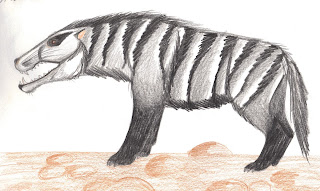
Paleoparadoxia tabatai Tokunaga, 1929
Paleoparadoxiidae; Desmostylia; Mammalia; Chordata
Graphite pencil illustration from original cast at Natural History Museum
December 2008
What an unusual beast Paleoparadoxia must've been. Somewhat like a hippo crossed with a manatee crossed with a fur seal, this beast lived in Miocene Japan and North America (10 to 20 million years ago). The desmostylians were an unusual order of animals placed in the Afrotheria (a superorder of mammals containing those animals with an origin in Africa, such as elephants, hyraxes, sea cows and elephant shrews). Their most unusual feature, which cannot be made out in my illustration (nor the original cast!) is their teeth. 'Desmostylia' means 'bonded pillars', and this is an excellent description of the cheek teeth; you don't believe me, do you? See this illustrated web page. In some ways, these teeth resemble aardvarks', since they completely lack a centre to the teeth.

Smilodon fatalis (Leidy, 1868)
Felidae; Carnivora; Mammalia; Chordata
Graphite pencil illustration from original cast at Natural History Museum
December 2008
Every-one knows the sabre-toothed tiger (more properly called 'sabre-toothed cat', as it is distantly related to tigers, let alone the other species of cat). This doesn't make it any less of a good specimen to draw. I had a lot of fun drawing this specimen and Paleoparadoxia. I drew both on the same day, around Xmas, and as such had lots of critics and admirers in the form of kids. Most were really complimentary, but all asked questions. It's always fun to draw in public, and I wish I could do it more often. The only times I get to see any of the specimens nowadays is when I'm zooming between libraries carrying a huge sackful of books and journals.

Andrewsarchus mongoliensis Pao, 1923
Triisodontidae; Mesonychia; Mammalia; Chordata
Colour pencil illustration
November 2008
Looking like a giant hoofed hyaena, Andrewsarchus must have been a terrifying animal to come across. It is larger than any land-based carnivore found today (yes, larger than a polar bear!) and has many menacing teeth. It isn't related to today's carnivores, however, being more closely related to sheep. You might say it's a sheep in wolf's clothing.
Andrewsarchus ("Andrews' ruler") may have been an active hunter, but was more likely to have scavenged on the bones of larger ungulates and even sea turtles. It lived in central Asia, but it wasn't 'central' at the time. During the late Eocene (40 million years ago), the Indian subcontinent hadn't collided with central Asia, so there would have been coastlines in northern Pakistan, Mongolia and Tibet, now totally landlocked. Incidentally, once India became one with Asia, the last remnants of the Tethys Ocean were gone.
I will be back this week with some rather good photos from Colchester Zoo. Have your say, what would you like to see first? A half-blind seal? A prehensile-tailed carnivoran? A female atelid impersonating a male? A balding monkey? An angry white tiger? A mixed pack of wolves? A gorgeous Cuban crocodile? A high-fiving chimp? The choice is yours.


3 comments:
Crocodile!!! :P
I dig your Paleoparadoxia, though the head proportions are a bit big for the body. I would love to see how you would reconstruct it in life.... I'm adding some goodies about Desmostylia to my blog, The Aquatic Amniote, soon, including a collection of reconstructions through the ages!
Keep up the good work. I also really like your Andrewsarchus - although I have to admit, considering that the only specimen is a skull with a very tiny occiput, I wouldn't be surprised if we someday find out it had flippers!
Thanks! I think the big head has something to do with the angle I was drawing from. Looking forward to the reconstructions... I would give it a go, but honestly don't have a clue how it would look. I should have a stab at it though, I might surprise myself!
Of course, I forgot there's only a skull of Andrewsarchus, so it might be less hyaena and more whale!
Post a Comment